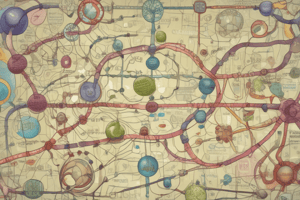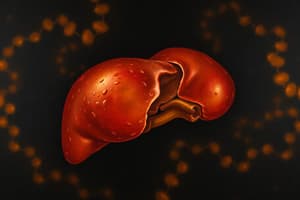Podcast
Questions and Answers
What is the main focus of metabolism?
What is the main focus of metabolism?
- Regulation of blood sugar levels
- Transport of oxygen in the body
- Synthesis of hormones
- Interconversion of chemical compounds in the body (correct)
Which type of pathway involves the synthesis of larger compounds from smaller precursors?
Which type of pathway involves the synthesis of larger compounds from smaller precursors?
- Exothermic pathways
- Amphibolic pathways
- Anabolic pathways (correct)
- Catabolic pathways
What characterizes catabolic pathways?
What characterizes catabolic pathways?
- They involve synthesis reactions
- They are endothermic
- They produce reducing equivalents
- They are exothermic (correct)
Which pathway acts as a link between anabolic and catabolic pathways?
Which pathway acts as a link between anabolic and catabolic pathways?
What type of reaction do catabolic pathways commonly involve?
What type of reaction do catabolic pathways commonly involve?
Which category of pathways is mainly responsible for producing ATP?
Which category of pathways is mainly responsible for producing ATP?
What is the primary metabolic fuel for most tissues in the fed state?
What is the primary metabolic fuel for most tissues in the fed state?
Which tissues rely wholly on glucose as a metabolic fuel in the fasting state?
Which tissues rely wholly on glucose as a metabolic fuel in the fasting state?
What do muscle and liver primarily oxidize when glucose availability decreases?
What do muscle and liver primarily oxidize when glucose availability decreases?
What is the process by which the liver synthesizes ketone bodies from fatty acids?
What is the process by which the liver synthesizes ketone bodies from fatty acids?
What is the main consequence of impaired sensitivity of tissues to insulin action in type II diabetes?
What is the main consequence of impaired sensitivity of tissues to insulin action in type II diabetes?
In what condition does impaired synthesis and secretion of insulin occur, leading to severe metabolic derangement?
In what condition does impaired synthesis and secretion of insulin occur, leading to severe metabolic derangement?
Which tissue stores glycogen as a fuel for muscle contraction during prolonged fasting or starvation?
Which tissue stores glycogen as a fuel for muscle contraction during prolonged fasting or starvation?
What is the main fuel reserve of the body stored in Adipose Tissue?
What is the main fuel reserve of the body stored in Adipose Tissue?
Which organ synthesizes urea and exports ketone bodies to provide fuel during fasting and starvation?
Which organ synthesizes urea and exports ketone bodies to provide fuel during fasting and starvation?
Where are excess amino acids deaminated to synthesize urea for excretion?
Where are excess amino acids deaminated to synthesize urea for excretion?
Which tissue accounts for approximately 50% of body mass and serves as a significant store of protein for amino acid supply during starvation?
Which tissue accounts for approximately 50% of body mass and serves as a significant store of protein for amino acid supply during starvation?
In which tissue is triacylglycerol first metabolized by lipoprotein lipase before being incorporated into tissue lipids or oxidized as fuel?
In which tissue is triacylglycerol first metabolized by lipoprotein lipase before being incorporated into tissue lipids or oxidized as fuel?
Which type of reactions are normally present in a metabolic pathway?
Which type of reactions are normally present in a metabolic pathway?
Why are enzymes catalyzing nonequilibrium reactions usually present in low concentration?
Why are enzymes catalyzing nonequilibrium reactions usually present in low concentration?
What is a flux-generating reaction in a metabolic pathway?
What is a flux-generating reaction in a metabolic pathway?
Why is the first reaction in glycolysis, catalyzed by hexokinase, considered a flux-generating step?
Why is the first reaction in glycolysis, catalyzed by hexokinase, considered a flux-generating step?
How does the availability of the initial substrate regulate the flux of metabolites through metabolic pathways?
How does the availability of the initial substrate regulate the flux of metabolites through metabolic pathways?
In response to which hormone do muscle and adipose tissue take up glucose from the bloodstream?
In response to which hormone do muscle and adipose tissue take up glucose from the bloodstream?
What happens in prolonged starvation regarding protein catabolism?
What happens in prolonged starvation regarding protein catabolism?
What happens in patients with cachexia as a result of tumors and disease?
What happens in patients with cachexia as a result of tumors and disease?
What can lead to ketosis in pregnancy and lactation?
What can lead to ketosis in pregnancy and lactation?
How does poorly controlled type 1 diabetes mellitus affect glucose levels?
How does poorly controlled type 1 diabetes mellitus affect glucose levels?
What happens in adipose tissue due to lack of insulin action in poorly controlled type 1 diabetes mellitus?
What happens in adipose tissue due to lack of insulin action in poorly controlled type 1 diabetes mellitus?
What is the consequence of essential tissue proteins being catabolized and not replaced?
What is the consequence of essential tissue proteins being catabolized and not replaced?
What can lead to ketosis in pregnancy and lactation?
What can lead to ketosis in pregnancy and lactation?
In poorly controlled type 1 diabetes mellitus, why do patients become hyperglycemic?
In poorly controlled type 1 diabetes mellitus, why do patients become hyperglycemic?
Why does death result in patients with cachexia?
Why does death result in patients with cachexia?
What is the consequence of a very considerable increase in protein catabolism in prolonged starvation?
What is the consequence of a very considerable increase in protein catabolism in prolonged starvation?
What happens to adipose tissue reserves in prolonged starvation?
What happens to adipose tissue reserves in prolonged starvation?
Why do patients with cachexia experience an increased metabolic rate?
Why do patients with cachexia experience an increased metabolic rate?
What is the main metabolic abnormality observed in cachexia as a result of tumors and disease?
What is the main metabolic abnormality observed in cachexia as a result of tumors and disease?
What is the characteristic of the Km of enzymes catalyzing flux-generating reactions in metabolic pathways?
What is the characteristic of the Km of enzymes catalyzing flux-generating reactions in metabolic pathways?
Why are enzymes catalyzing nonequilibrium reactions usually present in low concentrations in metabolic pathways?
Why are enzymes catalyzing nonequilibrium reactions usually present in low concentrations in metabolic pathways?
Which factor primarily determines the availability of the initial substrate in regulating the flux of metabolites through metabolic pathways?
Which factor primarily determines the availability of the initial substrate in regulating the flux of metabolites through metabolic pathways?
In poorly controlled type 1 diabetes mellitus, what response do muscle and adipose tissue have to glucose in the bloodstream?
In poorly controlled type 1 diabetes mellitus, what response do muscle and adipose tissue have to glucose in the bloodstream?
What effect does a considerable increase in protein catabolism during prolonged starvation have on the body?
What effect does a considerable increase in protein catabolism during prolonged starvation have on the body?
Which characteristic of the first reaction in glycolysis makes it a flux-generating step?
Which characteristic of the first reaction in glycolysis makes it a flux-generating step?
What determines whether muscle and adipose tissue take up glucose from the bloodstream?
What determines whether muscle and adipose tissue take up glucose from the bloodstream?
'Most reactions in metabolic pathways cannot be classified as equilibrium or nonequilibrium' implies what about these reactions?
'Most reactions in metabolic pathways cannot be classified as equilibrium or nonequilibrium' implies what about these reactions?
'The flux through this pathway can be regulated by the availability of the initial substrate' highlights what regulatory aspect of metabolic pathways?
'The flux through this pathway can be regulated by the availability of the initial substrate' highlights what regulatory aspect of metabolic pathways?
Why is the Km of hexokinase for glucose in glycolysis compared to normal blood glucose concentration essential for its role as a flux-generating step?
Why is the Km of hexokinase for glucose in glycolysis compared to normal blood glucose concentration essential for its role as a flux-generating step?
Flashcards are hidden until you start studying
Study Notes
Nonequilibrium Reactions in Metabolic Pathways
- Metabolic pathways often contain nonequilibrium reactions, which are crucial for regulation and pathway flux.
- Enzymes for these reactions exist in low concentrations and are highly regulated.
- Most metabolic reactions are neither purely at equilibrium nor nonequilibrium but exist on a continuum between these states.
Regulation of Metabolite Flux
- Flux-generating reactions are identified as nonequilibrium, with a low Km (Michaelis constant) compared to substrate concentration.
- In glycolysis, hexokinase illustrates this with a Km for glucose of 0.05 mmol/L, significantly lower than normal blood glucose levels of 3-5 mmol/L.
- Substrate availability is influenced by food intake and tissue reserves releasing substrates, such as glycogenolysis in the liver.
Hormonal Influence on Metabolism
- Insulin facilitates glucose uptake in muscle and adipose tissues, impacting metabolic flux.
- Flux is also regulated by the removal of end products and the availability of cosubstrates or cofactors.
- Allosteric proteins often control nonequilibrium reactions, subject to feedback mechanisms based on cellular needs.
Interconversion of Metabolic Fuels
- Products from digestion, primarily glucose, fatty acids, glycerol, and amino acids, converge into acetyl-CoA for use in metabolic pathways, notably the citric acid cycle.
- Acetyl-CoA serves as a key substrate across multiple pathways, enabling metabolic flexibility.
- Gluconeogenesis can utilize lipolysis products and amino acids.
Categories of Metabolic Pathways
- Metabolic pathways are categorized into:
- Anabolic Pathways: Synthesize complex compounds from simpler precursors (e.g., protein from amino acids).
- Catabolic Pathways: Breakdown larger molecules, typically exothermic and producing ATP.
- Amphibolic Pathways: Serve as links between anabolic and catabolic processes, such as the citric acid cycle.
Metabolic Regulation and Energy Requirements
- Normal metabolism adapts to various states like fasting, exercise, and pregnancy.
- Abnormalities can arise from nutrient deficiencies, enzyme deficiencies, and hormonal imbalances.
- A 70-kg adult typically requires 1920-2900 kcal daily from carbohydrates (40-60%), fats (30-40%), and proteins (10-15%).
Tissue & Organ Level Metabolism
- Liver: Key role in glucose homeostasis; synthesizes glycogen and fatty acids and performs gluconeogenesis.
- Skeletal Muscle: Stores glycogen for energy during fasting and synthesizes proteins from plasma amino acids.
- Adipose Tissue: Serves as the main lipid reserve, releasing glycerol and fatty acids into circulation for energy use.
Subcellular Organization of Metabolic Pathways
- Metabolism functions in distinct subcellular compartments for effective regulation.
- Mitochondria: Site of the citric acid cycle, β-oxidation, and ATP synthesis.
- Cytosol: Location for glycolysis, pentose phosphate pathway, and fatty acid synthesis.
- Pathways like gluconeogenesis and the urea cycle involve both mitochondria and cytosol, highlighting metabolic integration.
Concept of Equilibrium in Reactions
- Reactions at equilibrium display equal rates for forward and reverse processes, leading to no net flux.
- Understanding equilibrium helps in recognizing how metabolic pathways can efficiently regulate themselves under varying conditions.
Studying That Suits You
Use AI to generate personalized quizzes and flashcards to suit your learning preferences.




